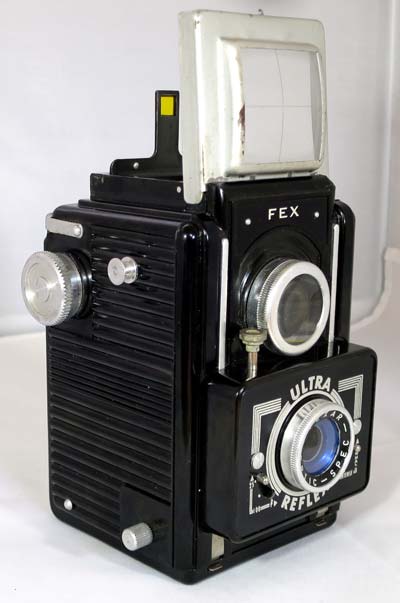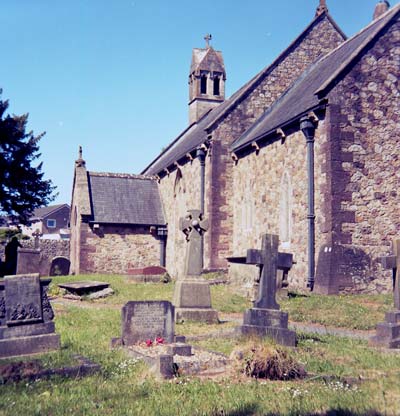Fex/Indo Ultra Reflex
Specification

| Manufacturer | : | Fex/Indo |
|---|---|---|
| Produced | : | 1952 |
| Classification | : | Medium Format |
| Body Type | : | Pseudo Twin Lens Reflex |
| Construction | : | Bakelite |
| Film Type | : | 620 |
| Film Width | : | 62mm |
| ImageSize | : | 2¼ x 2¼ in |
| No. of Images | : | 12 |
| Lens Type | : | Meniscus |
| Focus Type | : | Fixed |
| Focal Length | : | 85mm |
| Focal Range | : | 3m - inf. |
| Aperture Type | : | Multihole |
| Aperture | : | f/16; f/22 |
| Shutter Type | : | Rotary |
| Shutter Speeds | : | B, I(1/25s,1/100s) |
| Size Open(w x h x d) | : | 90 x 170 x 95 mm |
| Size Closed(w x h x d) | : | 90 x 130 x 95 mm |
| Weight | : | 545g |
Art Deco Credentials
![]()
![]()
![]()
Noteworthy: Worth giving special attention
- Produced after the main Art Deco period.
- Moulded Bakelite body.
- Multi-line deep ribbed pattern in Bakelite.
- Design shows stepped features.
- Multi-line geometric pattern in silver on face plate.
- Vertical silver line decoration on front.
Description
The camera is part of a range of cameras having similar design with regard to the heavily ribbed nature of the Bakelite body. The heavy ribbing was first seen in the Fex/Indo Superior camera which came out in 1940. The ribbed design continued until 1957. The film door is black enamelled metal.
The camera can be described as a pseudo twin lens reflex camera. It isn't a true TLR because the top lens is just part of the viewfinder and does not aid focussing. This is a 6cm x 6cm format camera giving 12 images on 120 film. The advance knob of the film is aluminum. There is a second aluminium knob which is secured to a threaded rod which serves as an axis to the supply reel.
The objective lens is labelled 'FEXAR - OPTIC - SPEC' and is a meniscus lens. It is surrounded by a bluish aluminum collar which stands out beautifully. It has 2 openings on a sliding aperture plate labelled "Normal" and "Intense". These were measured as f/16 and f/22. The shutter has 3 positions: 100, 25 and P (P = pose, corresponding to Bulb). The shutter release with a metal head is located on the lens plate. There is a red window to control film advance.
It has a large bright waist level reflex viewfinder but there is also a flip up eye level frame viewfinder. There is a yellow filter in the frame near to eye, for reason unknown. The large viewfinder frame has a clear plastic insert carrying some crosshairs. There is no adjustment of the focus with the objective lens set on the hyperfocal distance to give a clear image between 2 or 3 meters and infinity. A pc flash connector is provided with a accessory mount nearby. There is a thread for a tripod.
How to Use
This camera takes 620 film which is still available from selected photographic outlets. Although the actual film is the same as 120 film, the spools are different. The 620 spools are slightly shorter and have a smaller diameter. Do not use 120 film in this camera because it will jam and may snap. It is possible to cut down a spool of 120 film to fit or to re-spool some 120 film onto 620 spools in a darkroom or changing bag.
There is another issue with using modern film in this camera. The 620 spool must be the old metal type that has a hole right through to take the feed side spindle. Modern plastic spools will not work. So if you buy respooled 620 film which has a plastic spool, you will have to re-spool it yourself on to the old type metal spools. This process is similar to re-spooling 120 on to 620 spools.
To open the camera, simply lift the grey metal piece at the top of the back, then pull back out and slightly down. If that gets stuck, you will have to insert a knife blade at the top of the door and pry it open.
This camera has two aperture settings labelled 'normal' (f/16) and 'intense' (f/22). The available speeds are 1/25s and 1/100s
If you don't want to bother with an exposure meter, follow the guide shown. It is based on the 'Sunny 16' rule. Film is so forgiving and will produce acceptable results even when overexposed by 2 or 3 stops or underexposed by 1 stop.
Remember that the exposure guide in the camera user manual may not be helpful as it is based on the use of old film with a low ISO value.
The tables assume that the sun is at least 30 degrees above the horizon - that's 10am - 5pm on a summer's day (May to August) in the UK.
If you are not sure about the light level, err on the side of overexposure - i.e. assume the smaller f number.
Where there is a choice, a larger f number will give a larger depth of field.
For the slower speeds, you may need a tripod to stop blur through shake.
Using ISO 100/125
Key: Green - Good exposure; Amber - acceptable exposure; Red - unacceptable exposure. Number of stops over or under shown.
| Weather Conditions | Shadow Detail | Shutter Speed (s) | |
|---|---|---|---|
| 1/25 | 1/100 | ||
 Sunny SunnySnow/Sand | Dark with sharp edges | f/22 +2 over | f/22 |
 Sunny Sunny | Distinct | f/22 +1 over | f/16 |
 Slight Overcast Slight Overcast | Soft around edges | f/22 | f/16 -1 under |
 Overcast Overcast | Barely visible | f/16 | f/16 -2 under |
 Heavy Overcast Heavy Overcast | None | f/16 -1 under | f/16 -3 under |
 Open Shade Open Shade/Sunset | None | f/16 -2 under | f/16 -4 under |
Being fairly old, it would probably benefit from cleaning the lenses and viewfinders. This is easy to do and most worthwile. Check out my page:- 'Restoration of a Fex/Indo Ultra Reflex'.
Photographs taken with this Camera
Kodak Portra 160 film. Developed in Tetenal.



